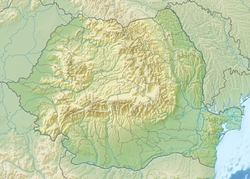
Halszka Osmólska was a Polish paleontologist who had specialized in Mongolian dinosaurs.
The Twin Mountains Formation, also known as the Twin Mak Formation, is a sedimentary rock formation, within the Trinity Group, found in Texas of the United States of America. It is a terrestrial formation of Aptian age, and is notable for its dinosaur fossils. Dinosaurs from this formation include the large theropod Acrocanthosaurus, the sauropod Sauroposeidon, as well as the ornithopods Tenontosaurus and Convolosaurus. It is the lowermost unit of the lower Cretaceous, lying unconformably on Carboniferous strata. It is overlain by the Glen Rose Formation. It is the lateral equivalent of the lower part of the Antlers Formation.
The Heiberg Formation is a geological formation in Northwest Territories, Canada.
The Moon-Airel Formation is a geological formation in France. It dates back to the late Rhaetian and early Hettangian.
The Suining Formation is a geological formation in China whose strata date back to the Early Cretaceous. Dinosaur remains are among the fossils that have been recovered from the formation. A 2019 paper shows zircon dating of the Suining Formation with a much younger age for the classically thought of Late Jurassic formation; the average age of the dating being roughly 114 myo or late upper Aptian. However, these results were subsequently challenged, with suggestions that the age of the zircons was affected by metamorphism, and that the zircons clustering around 145 Ma near the Jurassic Cretaceous boundary are closer to the correct date.
The Paw Paw Formation is a geological formation in Texas whose strata date back to the late Albian stage of the Early Cretaceous. Dinosaur remains are among the fossils that have been recovered from the formation.
The El Castellar Formation is a geological formation in La Rioja and Teruel, Spain whose strata date back to the possibly the Valanginian to the Barremian stages of the Early Cretaceous. Dinosaur remains are among the fossils that have been recovered from the formation.
The Yijinholuo Formation is a geological formation in Inner Mongolia, China whose strata date back to the Early Cretaceous. Dinosaur remains are among the fossils that have been recovered from the formation.
The Allison Formation is a geological formation in Alberta, Canada whose strata date back to the Late Cretaceous. Dinosaur remains are among the fossils that have been recovered from the formation.
The El Picacho Formation is a geological formation in Texas, United States, whose strata date back to the Late Cretaceous. Dinosaur remains are among the fossils that have been recovered from the formation. The paleosols found here are rich in clay, calcite, and rhizoliths which show that during the Cretaceous period, this fossil formation, just like the neighboring Javelina Formation and Aguja Formation, was a fluvial flood plain.

The Frontier Formation is a sedimentary geological formation whose strata date back to the Late Cretaceous. The formation's extents are: northwest Colorado, southeast Idaho, southern Montana, northern Utah, and western Wyoming. It occurs in many sedimentary basins and uplifted areas.

The Almond Formation is a geological formation of Late Cretaceous age in Wyoming. It was deposited in marsh, deltaic, lagoonal, estuarine, and shallow marine environments along the western shore of the Western Interior Seaway. It consists primarily of fine- to medium-grained sandstone, siltstone, shale, and coal. Fossils from the Almond Formation include remains of dinosaurs and plants.
The Medicine Bow Formation is a geological formation in Wyoming, United States, whose strata date back to the Late Cretaceous. Dinosaur remains are among the fossils that have been recovered from the formation.
La Bocana Roja Formation is a geological formation in Baja California, Mexico whose strata date back to the Late Cretaceous. Dinosaur remains are among the fossils that have been recovered from the formation.
The Glauconie argileuse is a geological formation in Europe whose strata date back to the Late Cretaceous. Dinosaur remains are among the fossils that have been recovered from the formation.
The Trichinopoly Group is a geological formation in India whose strata date back to the Late Cretaceous. It lies between the Ootatoor and Ariyalur Groups. It is broad in its southern extremity but thins as it gradually proceeds northwards as it ultimately meets the Ariyalur Group. Dinosaur remains are among the fossils that have been recovered from the formation.
The Minhe Formation is a geological formation in northwestern China, whose strata date back to the Late Cretaceous period.
The Zhumabao Formation is a geological formation in Shanxi, China whose strata date back to the Late Cretaceous. Dinosaur remains are among the fossils that have been recovered from the formation.
The Fangyan Formation is a geologic formation in China (Dongyang). It is made up of mainly conglomerates. It preserves dinosaur fossils dating back to the Late Cretaceous.




